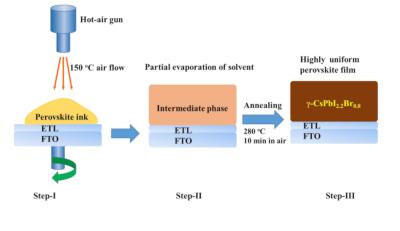Researchers at South Korea’s Chonnam National University have reported perovskite-organic hybrid tandem solar cells with 23.07% efficiency processed entirely in open air, bringing the technology a step closer to economic viability.
Schematic illustration of the synthesis of all-inorganic perovskite thin films by dynamic hot-air-assisted method. Image from Energy & Environmental Science
Researchers have largely relied on meticulously engineering the perovskite crystal structure itself for greater resilience. But these delicate handling steps add cost and complexity not suitable for mass production. The team explained that the focus has recently shifted toward all-solution processed solar cells due to their low energy consumption fabrication processes. The team’s innovation, a dynamic hot air deposition technique, simplified the production process by eliminating the need for humidity-controlled environments.
The team's approach demonstrates solution-processed absorbers with organic cation passivation reduce VOC loss down to 0.025 V, which is said to be the lowest reported to date. The scientists used fully air-processed ‘n-i-p’ front subcells in this process, which has reportedly led to a simplified approach toward commercialization with high reproducibility.
The research team fabricated both the front wide bandgap perovskite solar cell and the rear narrow bandgap organic solar cell layer in open air using a technique they call dynamic hot air deposition. They used a heat gun to crystallize metal halide salts spun onto the substrate directly from solution, avoiding problematic antisolvent baths. The researchers also employed novel chemical treatments to passivate each layer surface for effective charge transport.
The resulting all-inorganic cesium-lead-halide perovskite gained greatly enhanced moisture resistance compared to standard lead hybrid perovskites with volatile organic components. This enhancement in moisture resistance marks a significant advancement over standard lead hybrid perovskites, which contain volatile organic components and are less stable. Metallic rubidium doping further stabilized the perovskite crystal structure. The water-based synthesis and ambient processing method also eliminated the need for costly specialized equipment.
According to the team, It is established that the front perovskite subcell has a relatively strong absorber of visible light, peaking near ~450 nm, and presents a very high EQE over the whole visible range which compensates the deficiency of the relatively low EQE of the BHJs. The perovskite layer captures higher energy visible photons, while the polymer bulk heterojunction cell absorbs lower energy infrared.
The optimized devices combined a 1.87 eV rubidium-doped cesium-lead-halide perovskite front cell with a ternary polymer rear cell. This panchromatic tandem architecture reached a maximum 23.07% sunlight to electricity conversion efficiency. The open circuit voltage of 2.11 V significantly exceeds the 1.14 V typical of commercial silicon cells. Just as importantly, the cells retained over 90% of the peak performance after 600 hours of continuous simulated solar irradiation. By contrast, an unpassivated perovskite control cell dropped below half efficiency within 50 hours.
The scientists also found that the control device is more stable at 65 °C and 85 °C thermal stress than at room temperature. This is estimated by the team to occur due to a reduction in the moisture-induced phase decay pathway at elevated temperatures, as water molecules are desorbed from the surface. Further encapsulation for moisture protection allowed even better operational longevity.
The simplified ambient fabrication method also translated from 0.09 cm2 laboratory scale to over 21.82% efficiency for a practical 1 cm2 cell size.
The team is confident of approaching the 29.1% practical efficiency limit for the tandem solar cell architecture with further development.
The efficiency and stability of ambient-processed perovskite-organic tandem cells puts the technology on track to achieve the low manufacturing costs required for widespread photovoltaic adoption.




